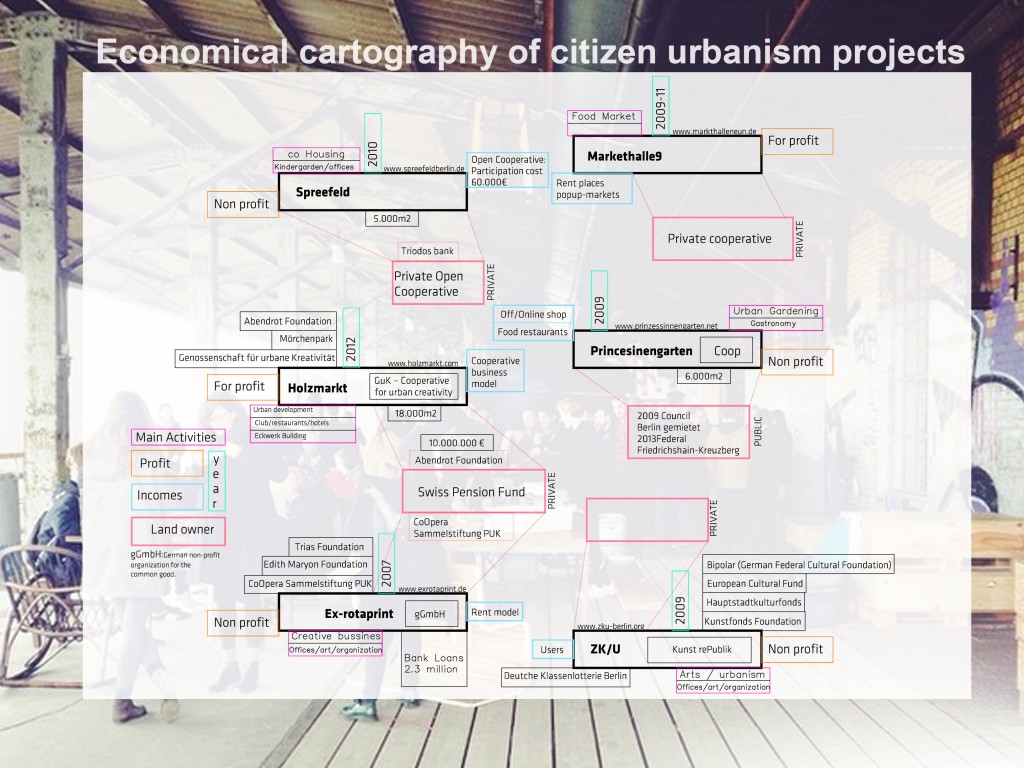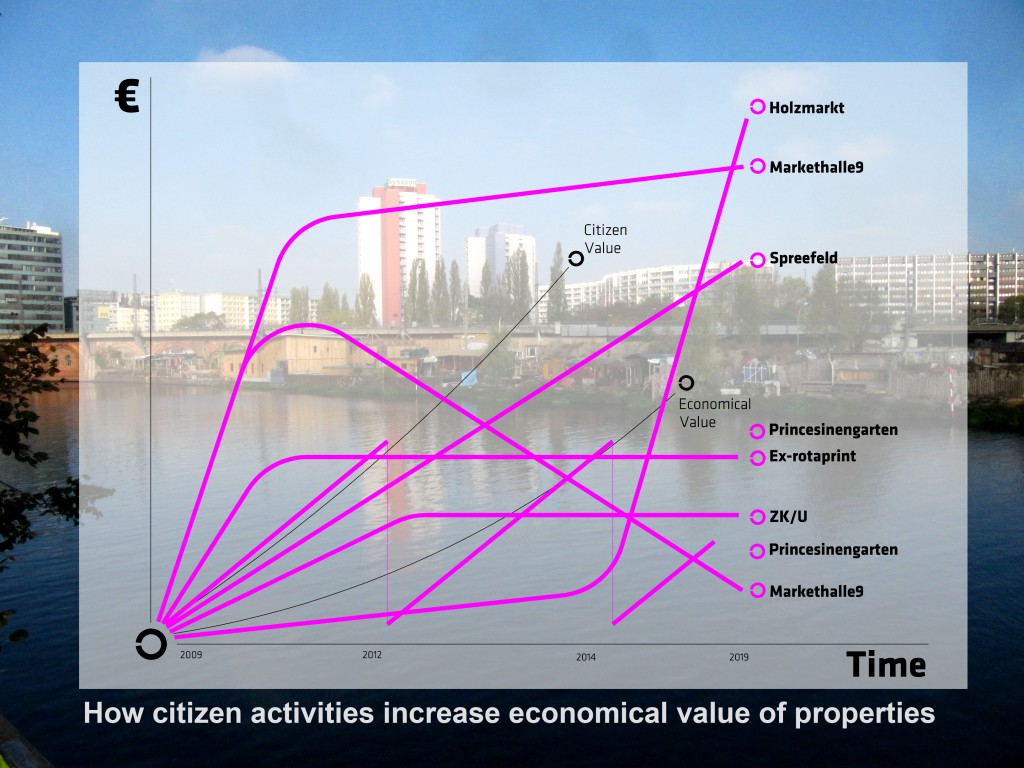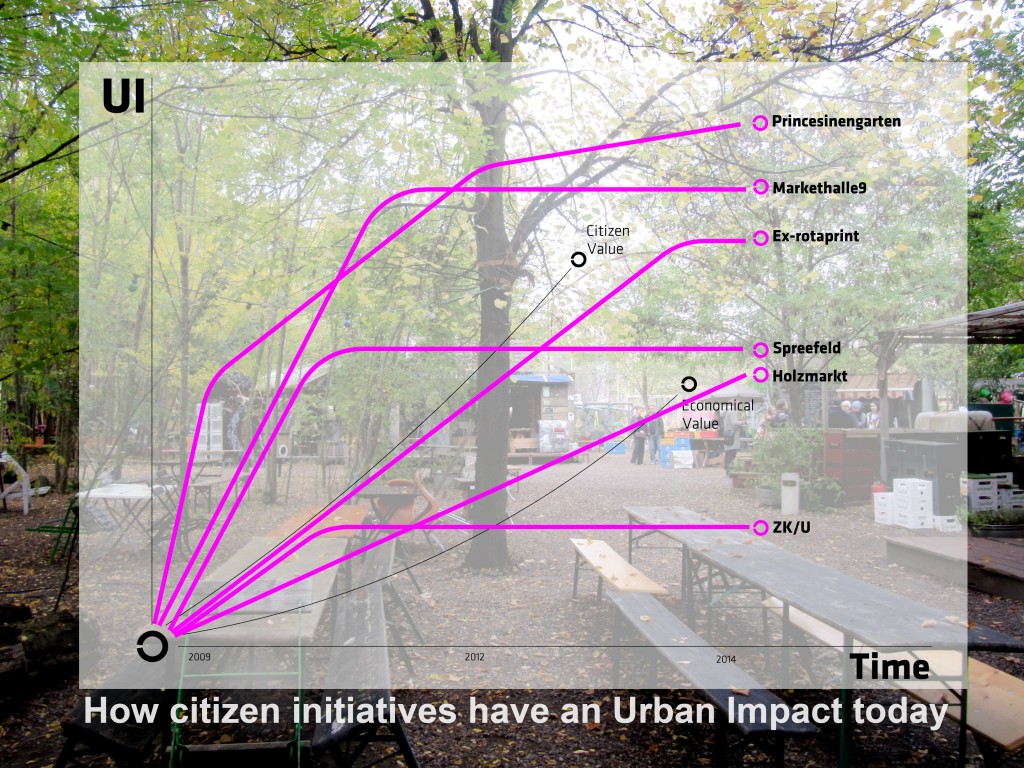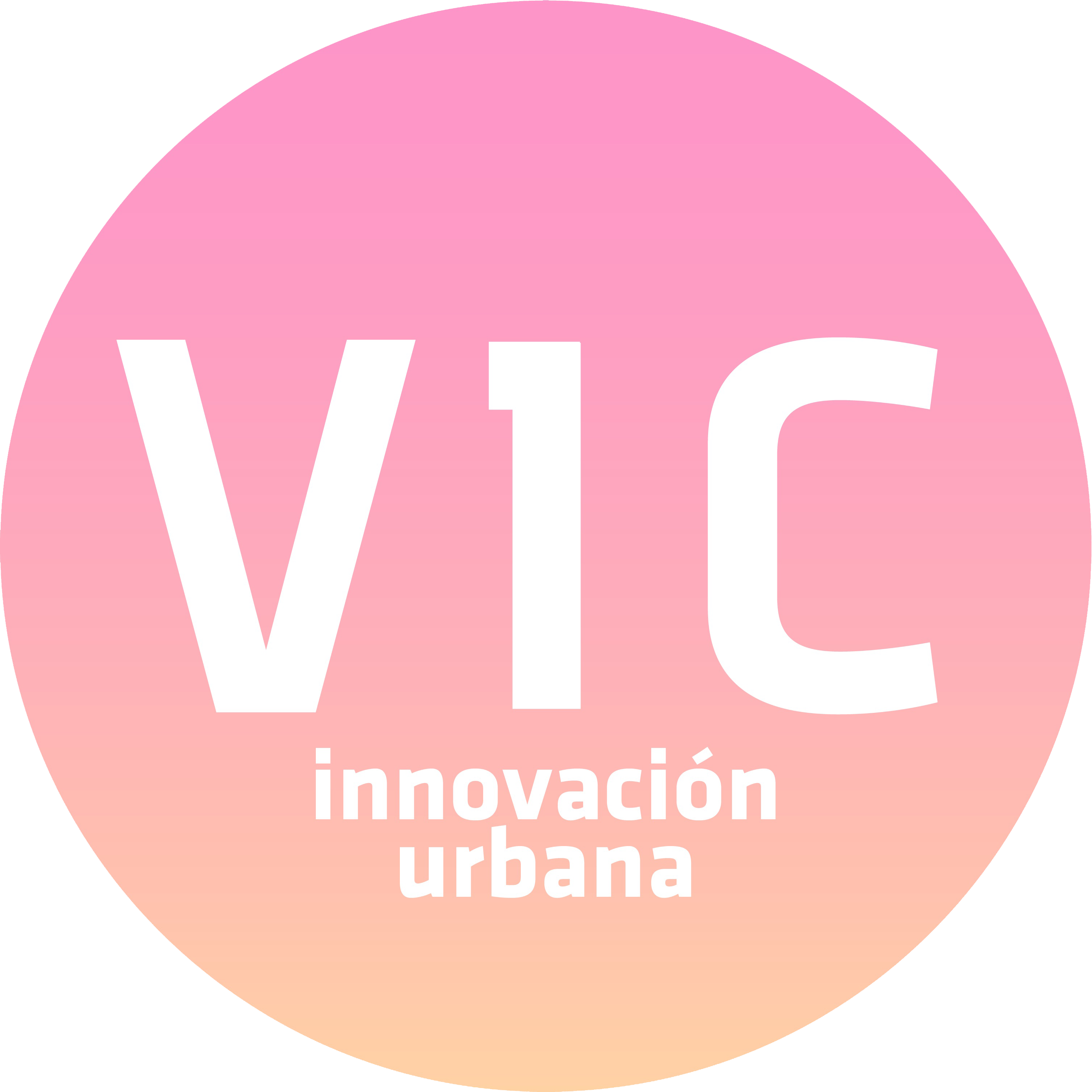Citizen urbanism.

This is only a reflection after 4 days workshop in the DAZ Architectural Centrum in Berlín organized by the European Wonderland platform. We met with 25 other offices to study, under economical point of view, 6 cases of citizen projects in Berlín area. The Funding Urbanism workshop give us three Keys to see new approaches for our way to understand next steps for a citizen urbanism. The projects we present are Spreefeld Cohousing, Holzmarkt development, Ex.rotaprint, ZK/U, Prinzessinengarten and Markethalle9.
prototipos, pedagogías, educación.
2015—07
prototipos, pedagogías, educación.
2015—07
Co-Funding is the new urban black.
The projects are a mixed between bottom-up process and middle-out strategies. That means they are hybrid processes between citizen ideas, collectives groups and platforms, cooperatives, Foundations, economical funds agencies and developers. To situate the extremes the Prinzessinengarten could be the most public appropiation or an urban void to manage a huge communitarian urban garden and the Holzmartk process implies a new way to understand an urban development with multitude of agents, companies in a very complex urban site in the Spree river.
The new thing for us is how this projects look for a power owner of the property. The land rescue the land of a market candidate with the highest bidder. In the Prinzessinengarten the people could get the land from the Berlin Council and now they got stability for that land now transferred to the Federal Berlín Goverment to allow them to stay 5 years more. Other projects as the ex- rotaprint and Holzmartk involve a Swiss Pension Funds as the best way to take the land by them and rent in a very good conditions the place to develop the different projects. Spreeflef for instance, made a cooperative for the co-housing, and everyone as a cooperative former put the money to buy the land with a Triodos Bank. All the projects have loans with different entities in a very good conditions. So there is a economical responsability to go further with the citizen projects in time and make them sustainable. The exrotaprint and ZK/U are models to have a limited economy that allows everyone to function by their own without increasing taxes or rent value of the places to work in.
We cannot make here and exhaustive analisis of each project but in a general term the 6 projects have very different funding agents that allows them to be economicaly sustainable: skateholders, Shareholders, Users, Enterpreuners, Institutions, Foundations join economical resources to allow this projects appear as a new way to understand citizen urbanism. As Ex-rotaprint says “ “Exrotaprint concerns urban development, the real estate and monetary economy, tendencies of social separation and exclusion, and art strategies within city politics, and is an example for developing new projects in urban space. Here a realm of possibility exists, non-profit and united, non-ideological but contingent on agreement and consensus.”
So the question also is if everyone should has a “Right to the Funding”? As this approach is only possible for a creative class with access to all the possible economical agents. Don´t forget we are talking about Berlin.

Multi-Gobernances is the only way.
If we define gobernances as a set of processes and relationships between actors that define the public decision-making, we will find in this projects different roles and process that are innovative in the way they understand the different aspects for decisions and conflicts.
– Administration as a framework, not as an agent.
– Who owns the land allows you to do what ever in a citizen sense but not to define a concrete program and proposal.
– Swiss Pension Funds are a relevant agent in Berlín.
– Informal citizen urbanism has a very formal structure.
– Users pays for the activities and the services this projects develop.
– Urban Cooperatives are the best economical infraestructure to organize citizen activities.
We talk about multigobernances because in this projects are many different agents that are not related closely with the others. For instance, the Holzmart project has strong ties with the DB public company and they built a framework and in other hand the citizen activities have another way to understand the daily use of the space and what is allowed and who can begin a deal in the urban lot.
Citizen Urbanism has also a great economical urban impact
Berlin knows how to manage and take advantage of the citizens activities. From the underground period, to the actual citizen initiatives, the administration is very consciousness on how the informal citizen practices attracts tourist and foreigns for other parts of germany and other countries. The incomes of this visits to the tourist also helps to support the citizen practies, actions or projects.
Maybe is much difficult to evaluate the urban impact of the Prinzessinengarten in terms of affective nets that builts, or the impact in the neighborhood of the sales of organic eco-food. Very clear in terms of how many people spent the weekend in it. So the Prinzessinengarten project asks themselves Are we useful now in the neighborhood? When they arrive 5 years ago the community was very different. How is the impact of this project in the gentrification process of kreuzberg? Maybe the project is more useful now in other parts of Berlin or Germany they asked themselfs. So here is another innovation for a resilient project.

In other hand, ZK/U or Ex rotaprint have a different engagemnet with community and the urban impact is very different. They recover an obsolete buildings working with the foundations funds with a renting model for the workers and social companies. Also their activity are increasing the value of the land and the building in a socially marginalized area but they limited in ten years his incomes. As they clearly says “The non-profit GmbH disrupts the speculation-spiral of the real estate market and owns the buildings through a heritable building right. It is responsible for all aspects of project development, the financing, renting of spaces, and renovating the ExRotaprint site.Non-profit status dispels the conflict over partial ownership and allows for planning unencumbered by individual interests. ExRotaprint gGmbH partners do not profit from the income generated by the property and cannot realize any increase in value from a sale of their stake in the partnership. Thus a long-term and stable location is created that can be developed on its own terms.”
Finally, The Markethalle9 case has a more tradicional way of finance but they rescue again the market for the speculative process for a big supermarket to a more social and ecological sustainable project in the area. In three years time the cooperative had paid the investment an now is time for the profits. The project had increased the value of the neighborhood and their daily activities allows to have more liveable time during the days. The Holzmarkt development has a very different approach. For a decade, Bar 25 was one of Berlin’s wildest clubs. Now, its founders want to create a new development on the site. It is to cater to former clubbers and preserve an element of 1990s Berlin. But the hurdles are high. As this article for Der Spiegel explains the Night-life undergrouns Berlin promoters are now the ones who are building new urban developments with in the citizens. This is a “for profit” project with an investment of 10.000.000 euros to develop cultural, night life, students housing and offices building in the area. We will be the social impact of this project in a near future, but for their promoters the investment would be a best way to undertand how citizens can build their own projects in a very different way than tradicionally highest bidder. For sure, this is a project that Berlin administration will promote and communicate Lifting the Underground into the Mainstream

Challenges:
We can share some challenges the cities could adapt to increase an intensive use of space, not only in the public sphere, and begin to experiment new models of making city with more complex ideas. As we say in the workshop: “From a self-organized appropiation of space to a professionalized governance model within a permisive institutional framework, which reconciliates the tension between self-sustaining and speculation, profit and democracy, short and long-term.”
– More permissive institutions.
– Finding funding mechanisms that don-t slave
– Tension between professionalization and democracy
– Define the role or framework of administration
– Space availabilty
– How to engage the market economy in a shared value economy from the citizen initiatives.
– How to construct a economic-sustainable model involving companies, markets, and also how communitie could change their willing to donate, support, or pay for it.
– How to share a proffesional management with a creative development
– If a super wealth economy could provide funds to citizen initiatives and spaces, could those investors come to the south?
– Are we ready for this approach?… we expect your point of view in the commentaries.
Funding urbanism workshop participants: Atelier Mob, City Hound,Urbego, LCC, Stealth, Homebaked, Bostjan Bugaric, Kristien Ring, Kateryna Romanova (winner of CANactions Prize) Fatkoehl architekten, urban Catalyst Studio, Valencia Vibrant, ASF Milan, CANactions, New Generations, Tore Dobberstein,Complizen, Urban Drift, Francesca Ferguson, VIC and Wonderland.
